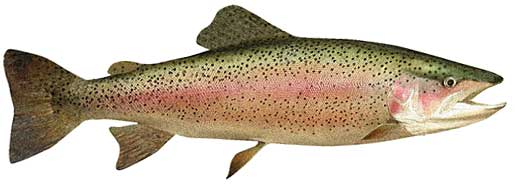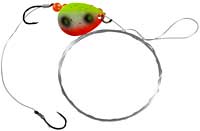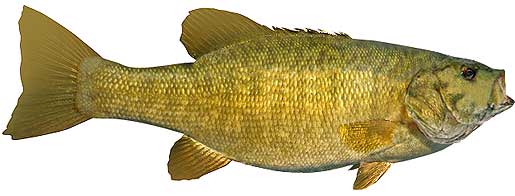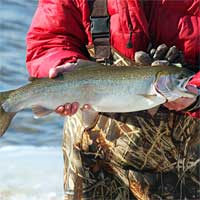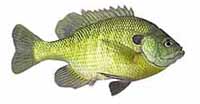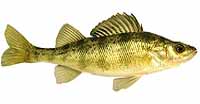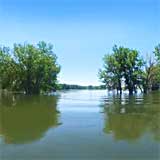Fishing Report For Chatfield Reservoir, CO
At Chatfield State Park
By Rick Seaman
Last updated on .
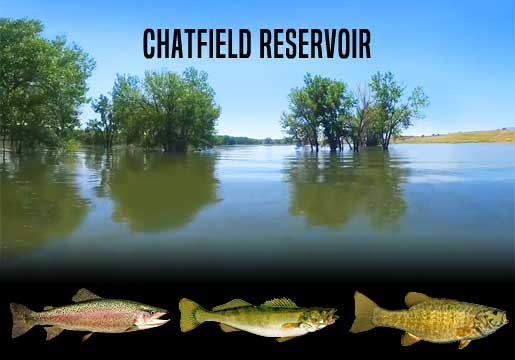
Fishing Reports
Popular Fish Species Chatfield Reservoir, CO
Rainbow Trout
Current Report: Good To Very Good
On-going stocking of rainbow trout into Chatfield Reservoir is helping to maintain a decent rainbow fishery. Salmon eggs, nightcrawlers and mealworms are popular baits, especially for newly stocked trout. Anglers chasing the larger rainbows report good success using Mepps, Rooster Tail, and Panther Martin Spinners.
FALL. Cooling water temperatures in the shallows, draw rainbow trout out of deeper Summer depths. Anglers are now catching them 12 to 25 feet deep on rocky banks, wind-blown points, rocky structure, humps, and anywhere baitfish are gathering. Now that they had a full summer to grow, there are some nice size rainbow to be caught. Small spinners, spoons, jigs, miniature crankbaits and swimbaits are good choices, as are salmon eggs and prepared baits. Later in Autumn, they move into 15 to 20 feet of water.
WINTER. When Winter sets in jigging spoons, and jigs tipped with bait, are catching nice limits of rainbows out of 25 to 35 feet of water. These baits work well before, during and after ice fishing season. After ice out, deep trolling with leaded line or downriggers, or vertical jigging with spoons and jigs, are the best approach during the cold-water season.
SPRING. As water begins to warm in early Spring, rainbow trout move from their late winter holding areas to shallow, warmer water 15 to 35 feet deep. A good number of rainbows are typically caught from mid morning to late afternoon, during the warmest water of the day. Shallow flats and rocky structure are quick to warm in the afternoon sun. A wide variety of small spinners, spoons and bait are catching most of the fish.
SUMMER. Once Summer is here to stay, the warmer water drives rainbow deeper, 15 to 35 feet deep, occasionally deeper. Trolling with spoons, spinners and crankbaits, using downriggers or leaded line, and drift fishing with bait, are currently the most productive methods. Following drop-offs into deeper water, along structure or creek channels, is a major key to getting bites. Anglers fishing from the bank are using nightcrawlers or Berkley PowerBait, with heavy weights on a Carolina rig, to get baits in deeper water.
Walleye
Current Report: Fair To Good
Most walleye stocked into Chatfield Reservoir are fingerlings, which flourish and grow to catchable size in the lake.
FALL. Fall brings cooler temperatures to shallow water, drawing walleye and baitfish shallower. Locals report good success on jigs and spinners tipped with minnows or nightcrawlers. My preference for catching walleye is trolling with deep-diving crankbaits, around flats and ledges. Early Fall finds them in 15 to 25 feet of water. Later in Fall, they move out deeper again. Dragging jigs or worm harnesses with nightcrawlers or leeches, or bottom bouncers, around ledge drop-offs catches walleye fairly consistently. Watch for the bigger walleye to be slightly deeper than the majority of the school.
WINTER. This Winter fishing for walleye was pretty good through the ice. Before, during and after the ice, anglers report catching them in 25 to 60 feet of water, along creek channel edges, rocky humps and ledges. They primarily feed on small fish, staying close to the bottom. After ice-out blade baits, jigs, swimbaits, spoons, deep-diving crankbaits, and worm harness spinners, are all working while deep trolling or slow drifting.
SPRING. Early Spring brings warming water in the shallows, and draws walleye here to feed, especially rocky areas and inlet channels. In Spring work the river area, and anywhere water is flowing in. Here, in 8 to 25 feet deep, they will spawn once the water warms to the mid to high 40's. When they move shallow, bright colored jigs, tipped with minnows or nightcrawlers typically catch them. Spinnerbaits, jerkbaits and crankbaits are also working up shallow. Afterwards, they move to 10 to 20 feet deep, around points, flats, shoals and ledges, often staying in close proximity to their spawning locations.
SUMMER. Water temperatures rise in Summer, and walleye fishing is good if you can get your bait deep enough. Walleye tend to concentrate in 20 to 35 feet of water, preferring the cooler temperatures. Throughout Summer, early in the morning, and from dusk to long after dark are good times to catch walleye. At those times they move slightly shallower to feed in low-light conditions. Night fishing is often good in Summer, as well. The rest of the time they are cruising flats and creek channel edges, where they are harder to locate. When the bite is slow, grubs and nightcrawlers, fished just off the bottom are catching walleye.
Smallmouth Bass
Current Report: Fair To Good
FALL. As Fall arrives, smallmouth here follow schools of baitfish into coves and bays 5 to 15 feet deep. Local smallmouth anglers report catching good numbers of smallies using tube baits. Rocky and gravel banks are ideal as crawfish live in these areas. Smallmouth favor crawfish over baitfish for the added nutritional value. Tube baits imitate small crawfish. They thrive in the cold, clean water, which is an ideal environment for them. Locals report that tube jigs are a great choice when the bass are in 15' or shallower. Drop shot rigs with small worms or shad shaped plastics are also popular in 10' water or deeper. Jerkbaits, deep-diving crankbaits, and slow-rolled spinnerbaits, are also successful. Later in Fall, smallies move to slightly deeper water, around 10 to 20 feet deep. Fishing shallow for smallmouth is often good on cold, windy, cloudy and rainy days.
WINTER. Winter will isolate them around deeper structure, points, flats and creek channels, often suspending in open water above these features. They can generally be found from 15 to 30 feet deep. Tube baits, jigging spoons, drop shots and Ned rigs often produce when fished with a very slow presentation. Here they hold, feeding less frequently, awaiting warmer water to return in Spring.
SPRING. After ice out, when water temperatures rise into the 50's, smallmouth move from deep wintering spots to shallower water, just outside spawning areas. They feed heavily in 5 to 15 feet of water at this time, and are typically caught on jerkbaits, crankbaits, tube baits, Ned rigs, and crayfish imitating plastics. Once water warms into the high 50's, they move into shallower water, and create nests in gravel or sand areas, then lay their eggs. Females then move to deeper water and males remain to guard the eggs, and then the fry. After a couple weeks, the males also move into 15 to 20 feet deep, and feed aggressively. Crankbaits, tube baits, Ned rigs, plastic worms, spoons and swimbaits are catching smallies during this period.
SUMMER. Smallmouth bass are currently feeding shallow early and late in the day in 8 to 12 feet of water. They are being caught on topwater, crankbaits, swimbaits, Ned rigs and tube baits. Smallmouth bass here feed on crawfish, gizzard shad, and small sunfish. They prefer rocky or gravel bottom areas, as this is where crayfish live. During the hotter parts of the day, they are being caught on points, humps, and ledges around 20 feet deep. Often these deeper fish are part of a large school of smallmouth.
Fishing Video
Fish species to fish for...
Guide to fishing for smallmouth bass, channel catfish, walleye, rainbow trout, bluegill and yellow perch at Chatfield Reservoir in Colorado.
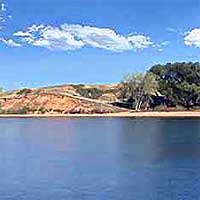 Chatfield Reservoir, just outside Denver has over 1,500 surface acres and over 25 miles of shoreline. Hiking paths around the lake provide accessibility to multiple sections of the lake for bank fishing. Chatfield Reservoir supports a variety of fish species, including trout, walleye, bass, catfish, and crappie.
Chatfield Reservoir, just outside Denver has over 1,500 surface acres and over 25 miles of shoreline. Hiking paths around the lake provide accessibility to multiple sections of the lake for bank fishing. Chatfield Reservoir supports a variety of fish species, including trout, walleye, bass, catfish, and crappie.
Primary fish species to catch
Today's Weather & Forecast
Fishing Boat Rentals
Click here for fishing boat rentals.
Marinas
Click here for marinas.
Public Boat Launch Ramps & Landings
Click here for boat ramps.
Fishing License
Click here for a Colorado fishing license.
Map - Fishing & Access
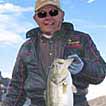 Rick Seaman is a fishing enthusiast with over five decades of fishing experience, a retired tournament fisherman, author of numerous published articles on fishing, and co-author of the book "Bass Fishing - It's not WHAT you throw, It's WHERE you throw it".
Rick Seaman is a fishing enthusiast with over five decades of fishing experience, a retired tournament fisherman, author of numerous published articles on fishing, and co-author of the book "Bass Fishing - It's not WHAT you throw, It's WHERE you throw it".
Contact Information
Chatfield Reservoir
11500 N. Roxborough Park Rd
Littleton, CO, 80125
303 791-7275
Fishing lakes in each state
101025
Chatfield Reservoir, CO Report
COLORADO


Bass, trout, perch and catfish fishing in north-central CO.


